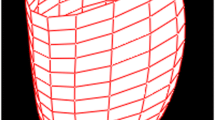Abstract.
The purpose of this study was to determine the reliability of new software developed for the analysis of cardiac tomographic data. The algorithm delineates the long axis and defines the basal plane and subsequently generates polar maps to quantitatively and reproducibly assess the size and severity of perfusion defects. The developed technique requires an initial manual estimate of the left ventricular long axis and calculates the volumetric maximum myocardial activity distribution. This surface is used to map three-dimensional tracer accumulation onto a two-dimensional representation (polar map), which is the basis for further processing. The spatial information is used to compute geometrical and mechanical properties of a solid model of the left ventricle including the left heart chamber. A new estimate of the axis is determined from this model, and the previously outlined procedure is repeated together with an automated definition of the valve plane until differences between the polar maps can be neglected. This quantitative analysis software was validated in phantom studies with defects of known masses and in ten data sets from normals and patients with coronary artery disease of various severity. We investigated the reproducibility of the maps with the introduction of a similarity criterion where the ratio of two corresponding polar map elements lies within a 10% interval. The maps were also used to measure intra–and interobserver variability in respect of defect size and severity. In the phantom studies, it was possible to reliably assess mass information over a wide range of defects from 5 to 60 g (slope: 1.02, offset –0.68, r = 0.972). Patient studies revealed a statistically significant increase in the reproducibility of the automatic technique compared with the manual approach: 54%±19% (manual) compared with 88%±9% (automatic) for observer 1 and 61%±20% vs 82%±5% for observer 2, respectively. The intervariability analysis showed a significant improvement from 59%±14% to 83%±7% in similar polar map elements and a significantly improved correlation in the calculation of severity (from r = 0.908 to 0.989) and extent (from r = 0.963 to r = 0.992) of the perfusion defects when the automated procedure was applied. It is concluded that, assuming a constant wall thickness and tissue density, absolute defect mass can be reliably estimated. Furthermore, the proposed software demonstrates a significant improvement in the generation of volumetric polar maps for the quantitative assessment of perfusion defects.
Similar content being viewed by others
Author information
Authors and Affiliations
Additional information
Received 15 April and in revised form 27 May 1998
Rights and permissions
About this article
Cite this article
Nekolla, S., Miethaner, C., Nguyen, N. et al. Reproducibility of polar map generation and assessment of defect severity and extent assessment in myocardial perfusion imaging using positron emission tomography. Eur J Nucl Med 25, 1313–1321 (1998). https://doi.org/10.1007/s002590050301
Issue Date:
DOI: https://doi.org/10.1007/s002590050301




